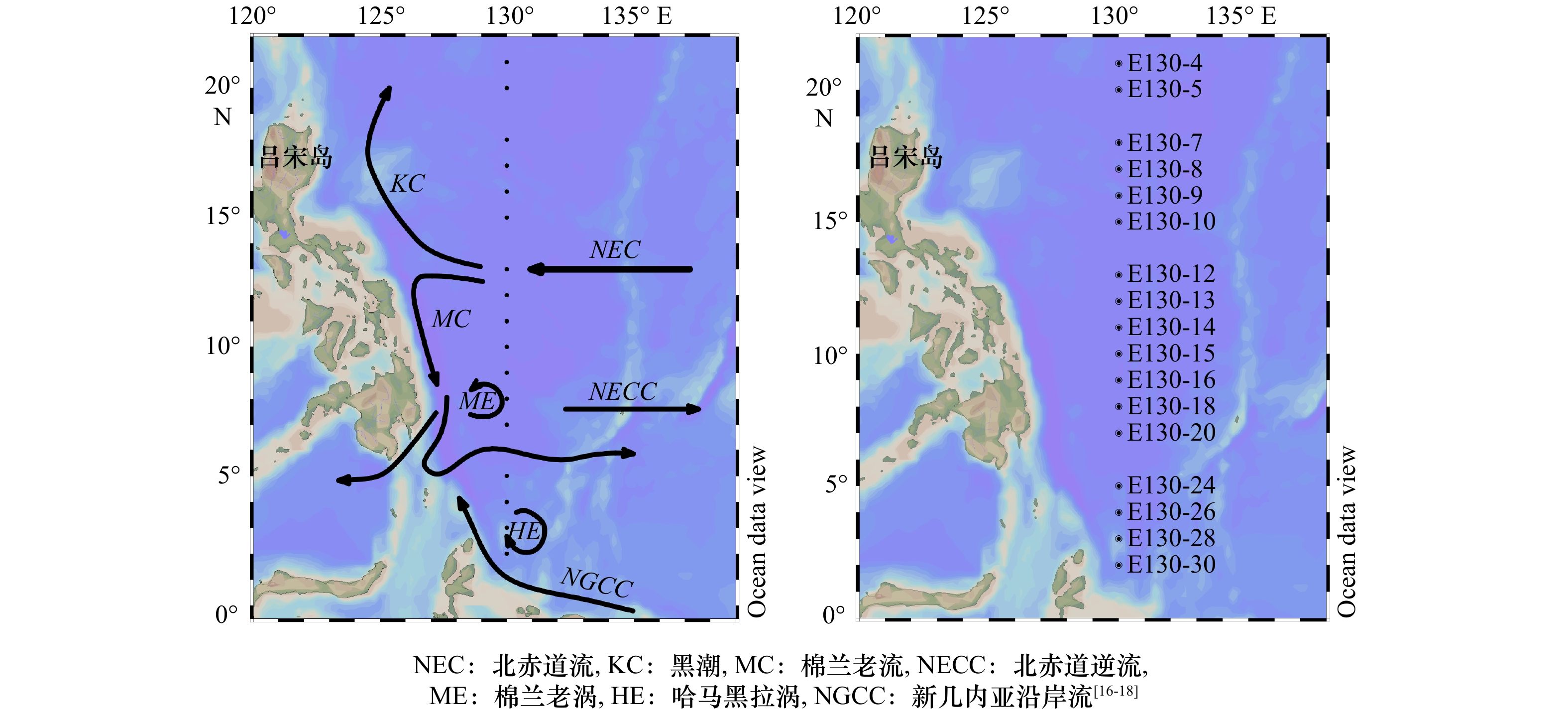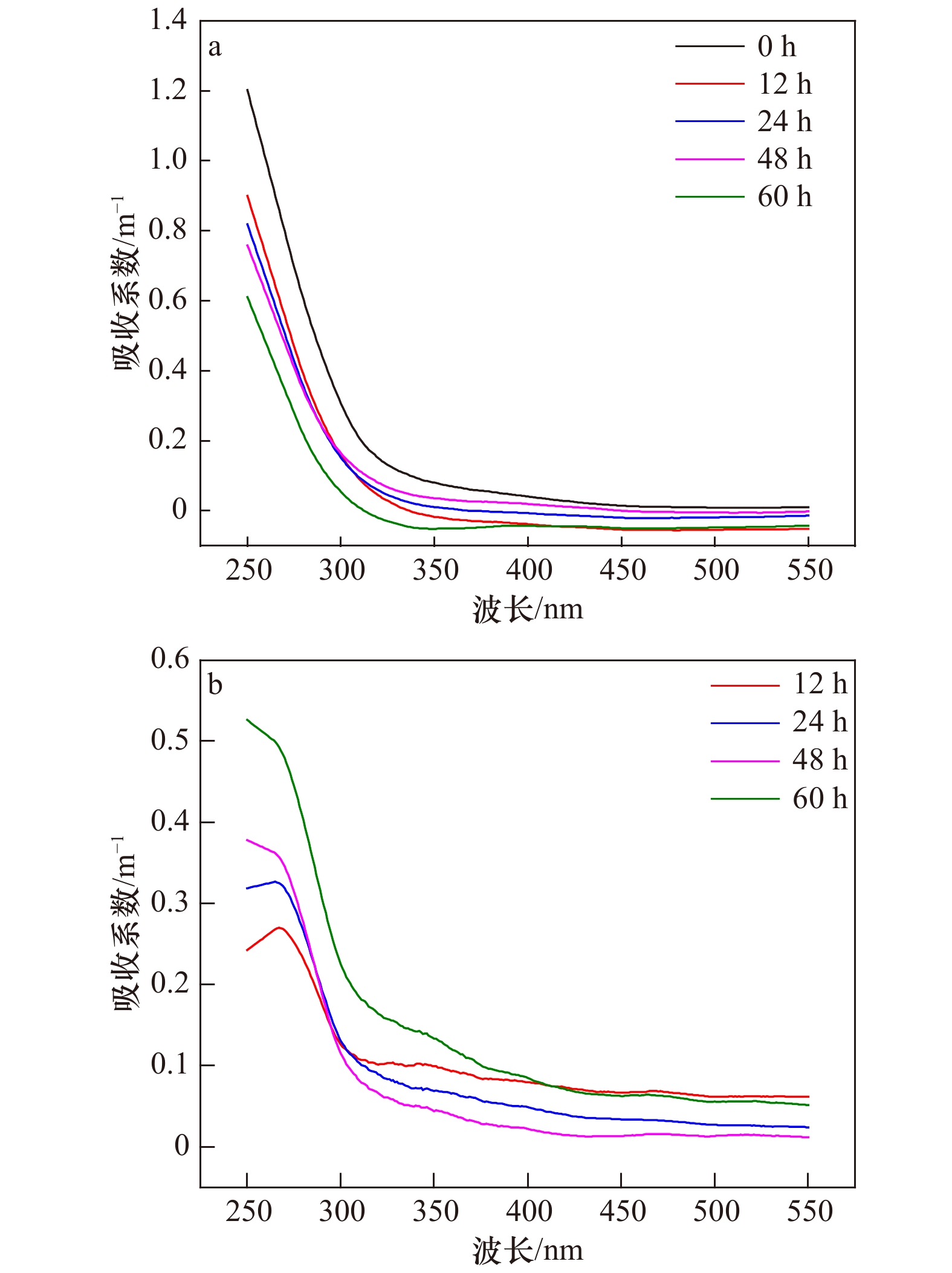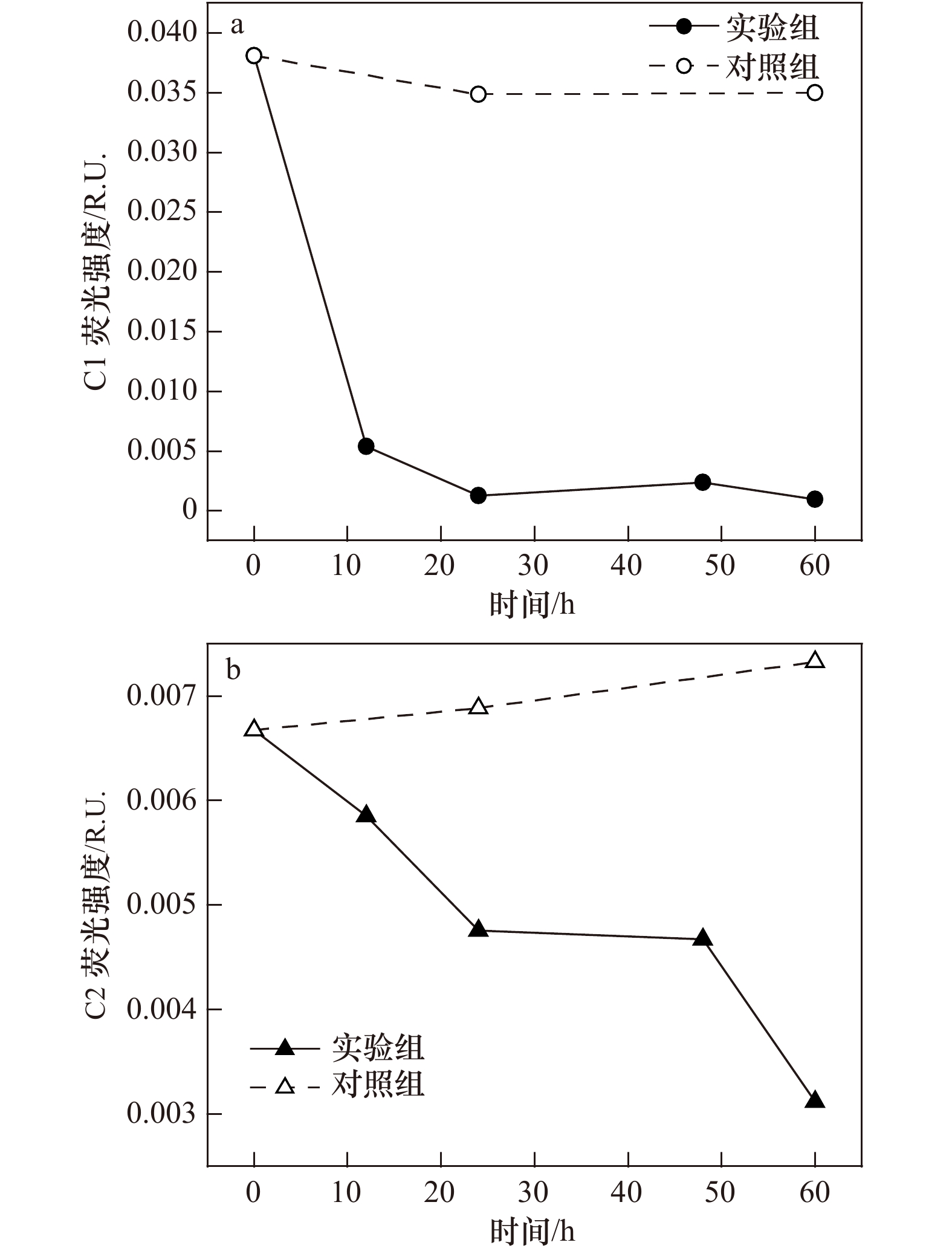Distribution and photodegradation behavior of CDOM along 130°E in the western Pacific Ocean
-
摘要: 对2018年秋季西太平洋130°E断面上层水体有色溶解有机物(CDOM)的光学特性及光降解行为进行了研究。结果表明,西太平洋上层水体CDOM的吸收系数a(320)变化范围为0.025~0.64 m−1,平均值为(0.20±0.08) m−1;a(320)在表层相对较低,主要与表层CDOM的光漂白去除有关;在100~200 m水层较高,主要与次表层的生物活动有关。利用三维荧光光谱−平行因子分析技术,识别出两种荧光组分:类酪氨酸组分C1和海洋类腐殖质组分C2。C1主要源于棉兰老冷涡−上升流所带来的营养物质对浮游植物生产活动和微生物活动的促进作用;C2主要源于黑潮所带来的海洋类腐殖的输入。光化学降解实验发现,CDOM吸收值的损失主要发生在紫外波段;光照60 h后,类酪氨酸组分相较于海洋类腐殖质组分更易发生光降解;且光降解是西太平洋海域CDOM的重要去除途径。Abstract: Photochemical properties and photochemical degradation of chromophoric dissolved organic matter (CDOM) were investigated in the upper water of the western Pacific Ocean during the autumn in 2018. The results showed that the absorption coefficient a(320) of CDOM ranged from 0.025 m−1 to 0.64 m−1, with an average of (0.20 ± 0.08) m−1. The a(320) showed relatively lower values in the surface water, which was mainly related to the photobleaching removal of the surface CDOM. The higher values of a(320) were observed in the 100−200 m water layers, which was mainly related to the biological production in the subsurface layer. The tyrosine-like component C1 and the marine humic-like component C2 were identified by FDOM excitation/emission matrix spectroscopy and a parallel factor analysis. The production of C1 was mainly originated from the production of phytoplankton and the degradation of microorganisms, while C2 was mainly originated from the input of the marine humic brought by Kuroshio. Moreover, the absorption loss spectra of CDOM indicated that the UV radiation was responsible for the photodegradation of CDOM. The tyrosine-like component was more susceptible to photodegradation than the marine humic-like component. The results also indicated that photodegradation was the important removal route of CDOM in the western Pacific Ocean.
-
表 2 西太平洋上层水体a(320)和荧光组分与温度、盐度、DO浓度、Chl a浓度、营养盐的相关性分析
Tab. 2 Correlation analysis of a(320) and fluorescent components with temperature, salinity, DO concentration, Chl a concentration, and nutrients in the upper waters of the western Pacific Ocean
温度 盐度 DO Chl a ${\rm {NO}}_3^- $-N ${\rm {NH}}_4^+ $-N ${\rm {PO}}_4^{3-} $ ${\rm {SiO}}_3^{2-} $ a(320) −0.557** 0.378** −0.451** −0.071 0.482** 0.018 0.457** 0.389** C1 −0.178 0.056 −0.189 −0.021 0.430** 0.312* 0.236 0.287* C2 −0.031 0.197 0.059 0.023 −0.205 −0.190 −0.128 −0.198 注:*表示显著相关(p<0.05),**表示极显著相关(p<0.01)。 表 1 西太平洋上层水体FDOM的主要荧光组分
Tab. 1 Principle fluorescent component of FDOM in the upper waters of the western Pacific Ocean
-
[1] Mayer L M. Sedimentary organic matter preservation: an assessment and speculative synthesis—a comment[J]. Marine Chemistry, 1995, 49(2/3): 123−126. [2] Andrew A A, del Vecchio R, Subramaniam A, et al. Chromophoric dissolved organic matter (CDOM) in the equatorial Atlantic Ocean: optical properties and their relation to CDOM structure and source[J]. Marine Chemistry, 2013, 148: 33−43. doi: 10.1016/j.marchem.2012.11.001 [3] Guo Weidong, Yang Liyang, Hong Huasheng, et al. Assessing the dynamics of chromophoric dissolved organic matter in a subtropical estuary using parallel factor analysis[J]. Marine Chemistry, 2011, 124(1/4): 125−133. [4] Wang Chao, Guo Weidong, Li Yan, et al. Hydrological and biogeochemical controls on absorption and fluorescence of dissolved organic matter in the northern South China Sea[J]. Journal of Geophysical Research, 2017, 122(12): 3405−3418. [5] Stedmon C A, Markager S. Resolving the variability in dissolved organic matter fluorescence in a temperate estuary and its catchment using PARAFAC analysis[J]. Limnology and Oceanography, 2005, 50(2): 686−697. doi: 10.4319/lo.2005.50.2.0686 [6] Yamashita Y, Tanoue E. In situ production of chromophoric dissolved organic matter in coastal environments[J]. Geophysical Research Letters, 2004, 31(14): L14302. doi: 10.1029/2004GL019734 [7] Nelson N B, Siegel D A. Chromophoric DOM in the open ocean[M]//Hansell D A, Carlson C A. Biogeochemistry of Marine Dissolved Organic Matter. Amsterdam: Elsevier, 2002: 547−554. [8] Nelson N B, Siegel D A, Michaels A F. Seasonal dynamics of colored dissolved material in the Sargasso Sea[J]. Deep-Sea Research Part I: Oceanographic Research Papers, 1998, 45(6): 931−957. doi: 10.1016/S0967-0637(97)00106-4 [9] Mopper K, Zhou Xianliang, Kieber R J, et al. Photochemical degradation of dissolved organic carbon and its impact on the oceanic carbon cycle[J]. Nature, 1991, 353(6339): 60−62. doi: 10.1038/353060a0 [10] Kim C, Nishimura Y, Nagata T. Role of dissolved organic matter in hypolimnetic mineralization of carbon and nitrogen in a large, monomictic lake[J]. Limnology and Oceanography, 2006, 51(1): 70−78. doi: 10.4319/lo.2006.51.1.0070 [11] Wetzel R G, Hatcher P G, Bianchi T S. Natural photolysis by ultraviolet irradiance of recalcitrant dissolved organic matter to simple substrates for rapidbacterial metabolism[J]. Limnology and Oceanography, 1995, 40(8): 1369−1380. doi: 10.4319/lo.1995.40.8.1369 [12] Fine R A, Lukas R, Bingham F M, et al. The western equatorial Pacific: a water mass crossroads[J]. Journal of Geophysical Research, 1994, 99(C12): 25063−25080. doi: 10.1029/94JC02277 [13] 李俊磊, 孙晓霞, 张文静, 等. 2014年冬季西太平洋浮游植物光合作用特征[J]. 海洋与湖沼, 2016, 47(5): 935−944.Li Junlei, Sun Xiaoxia, Zhang Wenjing, et al. Photosynthetic characteristics of phytoplankton in the western Pacific in winter 2014[J]. Oceanologia et Limnologia Sinica, 2016, 47(5): 935−944. [14] Yamashita Y, Tanoue E. Basin scale distribution of chromophoric dissolved organic matter in the Pacific Ocean[J]. Limnology and Oceanography, 2009, 54(2): 598−609. doi: 10.4319/lo.2009.54.2.0598 [15] 王泽华, 邹立, 陈洪涛, 等. 西太平洋冬季上层水体有色溶解有机物的分布和转化特征[J]. 海洋学报, 2018, 40(10): 180−189.Wang Zehua, Zou Li, Chen Hongtao, et al. Distribution and transformation of CDOM in the upper waters of the western Pacific Ocean in winter 2015−2016[J]. Haiyang Xuebao, 2018, 40(10): 180−189. [16] 李琦. 北太平洋低纬度西边界流的时空特征和变异规律研究[D]. 青岛: 中国科学院海洋研究所, 2009.Li Qi. Temporal and spatial characteristics and variation laws of the North Pacific Low Latitude West Boundary Currents[D]. Qingdao: Institute of Oceanology, China Academy of Sciences, 2009. [17] 李元龙. 热带西太平洋温跃层水团时空特征及中小尺度海洋过程的作用[D]. 青岛: 中国科学院海洋研究所, 2012.Li Yuanlong. Spatial and temporal variations of thermocline water masses in the western tropical Pacific Ocean and the effect of mesoscale and finescale oceanic processes[D]. Qingdao: Institute of Oceanology, China Academy of Sciences, 2012. [18] 翟方国, 胡敦欣, 王庆业. 哈马黑拉涡旋的季节变异研究[J]. 海洋科学, 2013, 37(11): 85−94.Zhai Fangguo, Hu Dunxin, Wang Qingye. Study on the seasonal variability of the Halmahera Eddy[J]. Marine Sciences, 2013, 37(11): 85−94. [19] 马海平. 黄海、东海海域有色溶解有机物(CDOM)的分布特征[D]. 青岛: 中国海洋大学, 2014.Ma Haiping. The study on characteristics and bistribution of chromophoric dissolved organic matter (CDOM) in the Yellow Sea and the East China Sea[D]. Qingdao: Ocean University of China, 2014. [20] Stedmon C A, Markager S, Kaas H. Optical properties and signatures of chromophoric dissolved organic matter (CDOM) in Danish coastal waters[J]. Estuarine, Coastal and Shelf Science, 2000, 51(2): 267−278. doi: 10.1006/ecss.2000.0645 [21] Carder K L, Steward R G, Harvey G R, et al. Marine humic and fulvic acids: their effects on remote sensing of ocean chlorophyll[J]. Limnology and Oceanography, 1989, 34(1): 68−81. doi: 10.4319/lo.1989.34.1.0068 [22] Helms J R, Stubbins A, Ritchie J D, et al. Absorption spectral slopes and slope ratios as indicators of molecular weight, source, and photobleaching of chromophoric dissolved organic matter[J]. Limnology and Oceanography, 2008, 53(3): 955−969. doi: 10.4319/lo.2008.53.3.0955 [23] Zepp R G, Sheldon W M, Moran M A. Dissolved organic fluorophores in southeastern US coastal waters: correction method for eliminating Rayleigh and Raman scattering peaks in excitation–emission matrices[J]. Marine Chemistry, 2004, 89(1/4): 15−36. [24] Bahram M, Bro R, Stedmon C, et al. Handling of Rayleigh and Raman scatter for PARAFAC modeling of fluorescence data using interpolation[J]. Journal of Chemometrics, 2006, 20(3/4): 99−105. [25] Bro R. PARAFAC. Tutorial and applications[J]. Chemometrics and Intelligent Laboratory Systems, 1997, 38(2): 149−171. doi: 10.1016/S0169-7439(97)00032-4 [26] 冷晓云, 杨阳, 孙军, 等. 夏季南海西部中尺度物理过程对营养盐和叶绿素a分布特征的影响[J]. 海洋学报, 2016, 38(4): 66−75.Leng Xiaoyun, Yang Yang, Sun Jun, et al. Mesoscale physical processes on the effects of distribution of nutrients and chlorophyll a in the western South China Sea in summer[J]. Haiyang Xuebao, 2016, 38(4): 66−75. [27] Zhu Wenzhuo, Zhang Jing, Yang Guipeng. Mixing behavior and photobleaching of chromophoric dissolved organic matter in the Changjiang River Estuary and the adjacent East China Sea[J]. Estuarine, Coastal and Shelf Science, 2018, 207: 422−434. doi: 10.1016/j.ecss.2017.07.019 [28] del Vecchio R, Blough N V. Photobleaching of chromophoric dissolved organic matter in natural waters: kinetics and modeling[J]. Marine Chemistry, 2002, 78(4): 231−253. doi: 10.1016/S0304-4203(02)00036-1 [29] Coble P G. Characterization of marine and terrestrial DOM in seawater using excitation-emission matrix spectroscopy[J]. Marine Chemistry, 1996, 51(4): 325−346. doi: 10.1016/0304-4203(95)00062-3 [30] Yamashita Y, Tanoue E. Chemical characterization of protein-like fluorophores in DOM in relation to aromatic amino acids[J]. Marine Chemistry, 2003, 82(3/4): 255−271. [31] Bridgeman J, Bieroza M, Baker A. The application of fluorescence spectroscopy to organic matter characterisation in drinking water treatment[J]. Reviews in Environmental Science and Bio/Technology, 2011, 10(3): 277−290. doi: 10.1007/s11157-011-9243-x [32] Chari N V H K, Sarma N S, Pandi S R, et al. Seasonal and spatial constraints of fluorophores in the midwestern Bay of Bengal by PARAFAC analysis of excitation emission matrix spectra[J]. Estuarine, Coastal and Shelf Science, 2012, 100: 162−171. doi: 10.1016/j.ecss.2012.01.012 [33] Yao Xin, Zhang Yunlin, Zhu Guangwei, et al. Resolving the variability of CDOM fluorescence to differentiate the sources and fate of DOM in Lake Taihu and its tributaries[J]. Chemosphere, 2011, 82(2): 145−155. doi: 10.1016/j.chemosphere.2010.10.049 [34] Luciani X, Mounier S, Paraquetti H H M, et al. Tracing of dissolved organic matter from the SEPETIBA Bay (Brazil) by PARAFAC analysis of total luminescence matrices[J]. Marine Environmental Research, 2008, 65(2): 148−157. doi: 10.1016/j.marenvres.2007.09.004 [35] Rochelle-Newall E J, Fisher T R. Production of chromophoric dissolved organic matter fluorescence in marine and estuarine environments: an investigation into the role of phytoplankton[J]. Marine Chemistry, 2002, 77(1): 7−21. doi: 10.1016/S0304-4203(01)00072-X [36] 刘子琳, 陈忠元, 周蓓锋, 等. 黑潮源区及其邻近海域叶绿素a浓度的季节分布[J]. 海洋湖沼通报, 2006(1): 58−63. doi: 10.3969/j.issn.1003-6482.2006.01.008Liu Zilin, Chen Zhongyuan, Zhou Beifeng, et al. The seasonal distribution of the standing stock of phytoplankton in the source area of the Kuroshio and adjacent areas[J]. Transactions of Oceanology and Limnology, 2006(1): 58−63. doi: 10.3969/j.issn.1003-6482.2006.01.008 [37] Zhu Wenzhuo, Yang Guipeng, Zhang Honghai. Photochemical behavior of dissolved and colloidal organic matter in estuarine and oceanic waters[J]. Science of the Total Environment, 2017, 607−608: 214−224. doi: 10.1016/j.scitotenv.2017.06.163 [38] 李奕洁. 长江口及邻近海域溶解有机物光化学降解行为研究[D]. 天津: 天津科技大学, 2015.Li Yijie. Study on the photodegradation of dissolved organic matter in the Yangtze Estuary and its adjacent sea[D]. Tianjin: Tianjin University of Science and Technology, 2015. [39] 郭卫东, 程远月. 天然日光辐照下河口区CDOM的光化学降解[J]. 环境科学, 2008, 29(6): 1463−1468. doi: 10.3321/j.issn:0250-3301.2008.06.002Guo Weidong, Cheng Yuanyue. Photodegradation of chromophoric dissolved organic matter from Jiulong River Estuary under natural solar radiation[J]. Environmental Science, 2008, 29(6): 1463−1468. doi: 10.3321/j.issn:0250-3301.2008.06.002 [40] Helms J R, Stubbins A, Perdue E M, et al. Photochemical bleaching of oceanic dissolved organic matter and its effect on absorption spectral slope and fluorescence[J]. Marine Chemistry, 2013, 155: 81−91. doi: 10.1016/j.marchem.2013.05.015 [41] Zhu Wenzhuo, Zhang Honghai, Zhang Jing, et al. Seasonal variation in chromophoric dissolved organic matter and relationships among fluorescent components, absorption coefficients and dissolved organic carbon in the Bohai Sea, the Yellow Sea and the East China Sea[J]. Journal of Marine Systems, 2018, 180: 9−23. doi: 10.1016/j.jmarsys.2017.12.003 -





 下载:
下载:





